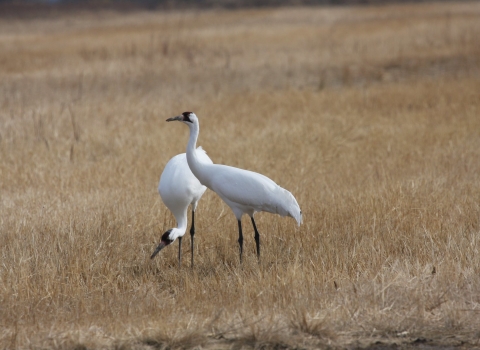The Service intends to use the updated and refined criteria on an interim basis to set land acquisition priorities for projects funded under the Land and Water Conservation Fund for the FY 2002 budget cycle. Based upon public comment and further refinements the Service will use the final criteria for the FY 2003 process and beyond. The priority system documents land acquisition needs and opportunities for the Service nationwide and helps prioritize land acquisition projects.
The criteria replace criteria developed in 1987 and modified in 1992. The criteria help implement the mandates of the National Wildlife Refuge System Improvement Act of 1997, which establishes a conservation priority for Refuge System lands. It also follows recommendations by the National Research Council Committee on Scientific and Technical Criteria for Federal Acquisition of Lands for Conservation that "each agency should develop individual criteria to rank its own acquisitions, because no single set of criteria will work to satisfy fully the different agency missions.
The Service-developed criteria consist of four components: Fisheries and Aquatic Resources, Endangered and Threatened Species, Bird Conservation, and Ecosystem Conservation.
The Fisheries and Aquatic Resources component, which includes listings of water shed "hot spots" with ten or more at risk fish and mussel species and water sheds deemed critical to the conservation of at risk fish and mussel species addresses:
o status and trends of aquatic populations;
o species diversity for trust resources, such as anadromous fish;
o critical habitats, including free-flowing rivers and watersheds;
o wetland types and trend status; and
o wetland losses by percent of historic wetland base by State.
The Endangered and Threatened Species component, which focuses on the recovery of species so they can eventually be removed from the list of endangered and threatened species, considers:
o habitat and biological community integrity as well as species occurrences; and
o actual habitat use.
The Bird Conservation component, which emphasizes both 70 nongame species of management concern and priority waterfowl species under the North American Wetlands Conservation Act, consists of:
o lists of birds of management concern for each of the seven Fish and Wildlife Service regions as well as Hawaii and Puerto Rico;
o a population importance index; and
o an avian diversity index.
The Ecosystem Conservation component, which incorporates a list of critically endangered, endangered and threatened ecosystems considers:
o biodiversity through distribution and abundance of rare communities;
o ecosystem decline and protection of native diversity of threatened ecosystems;
o landscape conservation by preserving large, intact habitats through partnerships; and
o contributions to national plans and designations.
The complete proposed criteria and system are available on the Internet at >. Paper copies are available from: LAPS Team Leader, Division of Realty, U.S. Fish and Wildlife Service, 300 Westgate Center Drive, Hadley, MA 01035, fax (413) 253-8480 or electronic mail to Andrew_French@fws.gov">.
Comments on the policy must be submitted to the address above on or before June 30, 2000. Comments sent by electronic mail should be formatted as ASCII files, without special characters or any form of encryption. The message also should include "Attn: LAPS Comments" and the senders name and return address.
The U.S. Fish and Wildlife Service is the principal Federal agency responsible for conserving, protecting and enhancing fish, wildlife and plants and their habitats for the continuing benefit of the American people. The Service manages the 93-million-acre National Wildlife Refuge System which encompasses more than 520 national wildlife refuges, thousands of small wetlands and other special management areas. It also operates 66 national fish hatcheries, 64 fishery resource offices and 78 ecological services field stations. The agency enforces Federal wildlife laws, administers the Endangered Species Act, manages migratory bird populations, restores nationally significant fisheries, conserves and restores wildlife habitat such as wetlands, and helps foreign governments with their conservation efforts. It also oversees the Federal Aid program that distributes hundreds of millions of dollars in excise taxes on fishing and hunting equipment to state fish and wildlife agencies.


